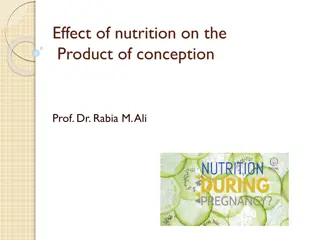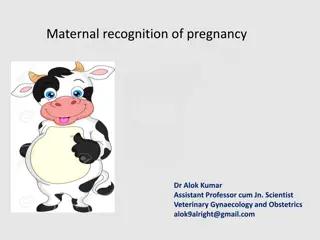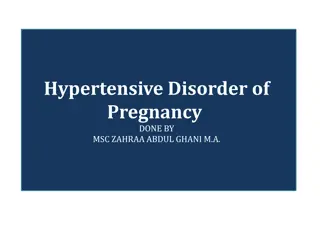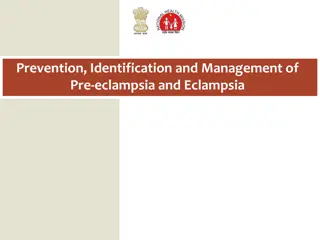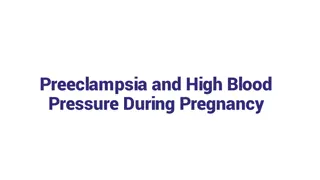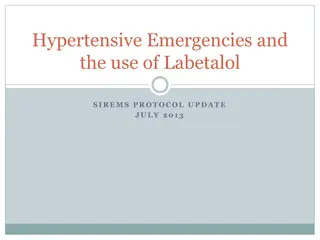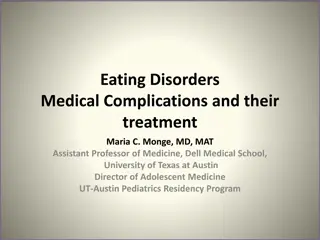Understanding Hypertensive Disorders in Pregnancy
This educational material discusses the classification of hypertension in pregnancy, different risks associated with hypertensive disorders, pathophysiology of pre-eclampsia, clinical presentation, management principles, long-term risks to mother and baby, and complications like eclampsia. It covers topics such as pregnancy-induced hypertension, chronic hypertension, and the seriousness of these conditions in affecting maternal and fetal health.
Uploaded on Sep 16, 2024 | 0 Views
Download Presentation

Please find below an Image/Link to download the presentation.
The content on the website is provided AS IS for your information and personal use only. It may not be sold, licensed, or shared on other websites without obtaining consent from the author. Download presentation by click this link. If you encounter any issues during the download, it is possible that the publisher has removed the file from their server.
E N D
Presentation Transcript
Ass. Prof. Dr. Sawsan Talib Department of Obstetrics and Gynecology College of medicine/ Diyala University Lec 2/4th stage /2021-2022
LEARNING OBJECTIVES To understand the classification of hypertension in pregnancy. To appreciate and be able to differentiate the different risks associated with various types of hypertensive disorders in pregnancy. To understand the pathophysiology of pre-eclampsia. To be aware of the clinical presentation of pre-eclampsia and understand the principles of management. To understand the long-term risks to both mother and baby from preeclampsia.
1/3 of it Majority of cases
Classification: Pregnancy-induced hypertension (Gestational hypertension alone): hypertension arising for the first time in the second half of pregnancy &in the absence of proteinuria or any other features of pre-eclampsia.It is not associated with adverse pregnancy outcome. Chronic hypertension: pre-existing hypertension may be diagnosed before gestation or assumed when a women is found to be hypertensive in early pregnancy. It can predispose to the later development of superimposed pre-eclampsia.
Complicates approximately 23% of pregnancies. It a leading cause of maternal death in low-resource settings. It defined as hypertension of at least 140/90 mmHg recorded on at least two separate occasions and at least 4 hours apart and in the presence of at least 300 mg protein in a 24-hour collection of urine, It arising after the 20th week of pregnancy in a previously normotensive woman Resolving completely by the sixth postpartum week.
Eclampsia: is a serious & life-threatening complication of pre-eclampsia.It is defined as convulsions occurring in a woman with established pre-eclampsia,in the absence of any other neurological or metabolic cause. It is an obstetric emergency. It may occur: Antepartum 40%. Intrapartum 20%. Postpartum 40%. Imminent eclampsia (fulminating pre-eclampsia): is the transitional condition characterized by increasing symptoms & signs, it s the sever form of pre-eclampsia
Chronic hypertension. The majority will have essential hypertension Secondary causes should be excluded. Can predispose to the later development of superimposed pre- eclampsia. Associated with increased maternal and fetal morbidity . The physiological fall in blood pressure that occurs in the first trimester secondary to peripheral vasodilatation can mask chronic hypertension. For example, a booking blood pressure of 138/88 mmHg, while still technically within normal limits, raises the suspicion of an underlying hypertensive tendency
Degrees of hypertension Mild: diastolic blood pressure 90 99 mmHg, systolic blood pressure 140 149 mmHg. Moderate: diastolic blood pressure 100 109 mmHg, systolic blood pressure 150 159 mmHg. Severe: diastolic blood pressure 110 mmHg, systolic blood pressure 160 mmHg
Pre-eclampsia is more common in first-time mothers. It is thought that the normal fetal maternal transfusion that occurs during pregnancy and particularly during delivery exposes the mother to products of the fetal (and hence paternal) genome, protecting her in subsequent pregnancies. In line with this, the protective effect of first pregnancy seems to be lost if a woman has a child with a new partner
Cardiovascular system Normal pregnancy marked peripheral vasodilatation fall in total peripheral resistance despite an increase in plasma volume and cardiac rate. Pre-eclampsia vasoconstriction hypertension The intravascular high pressure and loss of endothelial cell integrity results in greater vascular permeability and contributes to the formation of generalized oedema. marked peripheral
Renal system Highly characteristic lesion called glomeruloendotheliosis is seen. This is relatively specific for pre-eclampsia (it is not seen with other hypertensive disorders) Is associated with Impaired glomerular filtration Selective loss of intermediate weight proteins, such as albumin and transferrin, leading to proteinuria. This is turn causes a reduction in plasma oncotic pressure and exacerbates the development of oedema.
Haematological system In the event of endothelial damage, platelets adhere to the damaged area. Furthermore, diffuse vascular damage is associated with the laying down of fibrin. Pre-eclampsia is associated with increased fibrin deposition and a reduction in the platelet count may accompany and occasionally predate the onset of disease.
The liver In the liver, subendothelial fibrin deposition is associated with elevation of liver enzymes. Periportal necrosis Sub- capsular haematoma. This can be associated with haemolysis and a low platelet count due to platelet consumption (and subsequent widespread activation of the coagulation system). The presence of these finding is called HELLP syndrome
HELLP syndrome Is a particularly severe form of pre-eclampsia, Occurring in just 2 4% of women with the disease. It is associated with a high fetal loss rate (of up to 60%) Women with HELLP syndrome typically present with epigastric pain, nausea and vomiting. Hypertension may be mild or even absent. HELLP syndrome is associated with a range of serious complications including acute renal failure, placental abruption and stillbirth. The management of HELLP syndrome involves stabilizing the mother, correcting any coagulation deficits and assessing the fetus for delivery.
Neurological system The development of convulsions in a woman with pre-eclampsia is defined as eclampsia. Vasospasm and cerebral oedema have both been implicated in the pathogenesis of eclampsia. Retinal haemorrhages, exudates and papilloedema are characteristic of hypertensive encephalopathy and are rare in pre-eclampsia, Suggesting that hypertension alone is not responsible for the cerebral pathology.
The classic symptoms of pre-eclampsia include 1. Frontal headache 2. Visual disturbance 3. Epigastric pain. majority of women with preeclampsia are asymptomatic or merely complain of general vague flu-like symptoms Clinical examination should include a complete obstetric and neurological examination Hypertension is usually the first sign but occasionally is absent or transient until the late stages of the disease.
Dependent oedema of the feet is very common in healthy pregnant women. Rapidly progressive oedema of the face and hands may suggest pre-eclampsia. Epigastric tenderness is a worrying sign and suggests liver involvement. Neurological examination may reveal hyperreflexia and clonus in severe cases. Urine testing for protein should be considered part of the clinical examination
DIAGNOSIS: A diagnosis of pre-eclampsia usually requires admission of the patient for more intensive investigations & monitoring of her condition 1.) Mild form: BP mildly elevated i.e. diastolic BP of 90-95 mmHg. Minimal proteinuria. Normal haematological&biochemical parameters. Patient can be monitored as an outpatient, attending for regular fetal & maternal assessment. 2.) Moderate (95-105mmHg), it requires admission to the hospital for investigation &follow up.
3.) Sever pre-eclampsia is identified by symptoms of sever pre-eclampsia:- Frontal headache Visual disturbance Epigastric pain General malaise & nausea Restlessness Signs of sever pre-eclampsia: Agitation Hyper- reflexia(clonus) Facial &peripheral odema Right upper quadrant tenderness Poor urine output
The principles of management of pre-eclampsia are: Early recognition of the symptomless syndrome. Awareness of the serious nature of the condition in its severest form. Adherence to agreed guidelines for admission to hospital, investigation and the use of antihypertensive and anticonvulsant therapy. Well-timed delivery to pre-empt serious maternal or fetal complications. Postnatal follow-up and counselling for future pregnancies.
Investigation To monitor maternal complications: Full blood count (with particular emphasis on falling platelet count and rising haematocrit). If platelet values are normal, additional clotting studies are not indicated. Serum renal profile (including serum uric acid levels). Serum liver profile. Frequent repeat proteinuria quantification is probably unhelpful once a diagnosis of pre-eclampsia has been made.
To monitor fetal complications: Ultrasound assessment of: fetal size; amniotic fluid volume; maternal and fetal Dopplers. Antenatal cardiotocography, used in conjunction with ultrasound surveillance, provides a useful but by no means infallible indication of fetal wellbeing. A loss of baseline variability or decelerations may indicate fetal hypoxia
Treatment: # The mainstay of treatment is ending the pregnancy by delivering the fetus & placenta; this can be significant problem at 24-32 weeks. # The aim of antihypertensive therapy is to lower the BP & reduce the risk of maternal cerebrovasular accident without reducing uterine blood flow & compromising the fetus.
Antihypertensive drugs are: Methyldopa: centrally acting antihypertensive agent, safe, can only giving orally ,need at least 24 hours to work, & it is the drug of choice antenatally. Labetolol: is an alpha & beta- blocking agent ,it can be given orally or IV, safe , can be givenantenatally & intrapartum to control BP in sever pre-eclampsia . Nifedipine : calcium-channel blocker with a rapid onset of action.It can, however , cause sever headache that mimic worsening disease. Hydralazine : arterial vasodilator , used IV in sever pre- eclampsia. So sever form of pre-eclampsia , IV infusion of hydralazine/labetolol can be titrated rapidly against changes in the BP.
Management of eclampsia : # Maintain an open air way by mouth piece &oxygen . # Maintain an 2 IV line & take blood samples for : - Blood group &Rh. - CBC & Blood film. - LFT - RFT - Serum uric acid. - Coagulation profile. # Control fit by giving magnesium sulphate which is given IV as bolus dose directly & maintenance dose over 24 hours after last fit. # Control BP by hydralizin / labetolol IV . # Close observation of vital sign (PR,RR,BP,Temp.), urine output ,patellar reflex&clonus. # Assessment of fetal condition & immediate delivery.
Magnesium sulphate (MgSO4) *Centrally acting anticonvulsant drug. * act as membrane stabilizing agent. * can be given iv or im but preferable iv * Is the drug of choice (1stdrug of choice) in the acute phase treatment of eclamptic fit. *4-6 g given iv slowly over at least 10 min to arrest fit, then maintain on 1g / hr iv in drip for at least 24 hr from the last fit.
should be monitored carefully while giving it because of its toxicity by: 1.measuring its level in the blood 2.monitering the following a) respiratory rate. b) urine output. c) patellar reflexes (1stsign to disappear in MgSO4 toxicity). * antidote of MgSO4 toxicity is calcium gluconate10%, 10 ml over 10 min given iv.
Screening and prevention Unfortunately there is currently no screening test for pre-eclampsia. The ability of Doppler ultrasound uterine artery waveform analysis to identify women at risk of pre-eclampsia (and other adverse pregnancy outcomes) has been investigated with varying success In pregnancies with incomplete trophoblast remodelling of the spiral arteries, a characteristic notch can often be seen in the waveform pattern that frequently also demonstrates high resistance .
This screening test may have a role in women who have already been identified as being at risk of the disease because of their medical or past obstetric history. However, it is not of value in screening low-risk women. Established preventive interventions include low-dose aspirin (typically 75 mg daily), which modestly reduces the risk of pre-eclampsia in high-risk women; calcium supplementation may also reduce risk, but only in women with low dietary intake.
Additional points in management Iatrogenic premature delivery of the fetus is often required in severe preeclampsia so patient must be referred to tertiary center for care of fetus. 2. prior to 34 weeks gestation steroids should be given intramuscularly to reduce admition to NICU. 3. In preterm delivery should be by CS. 4. Such patients are at particularly high risk for thromboembolism and should be given prophylactic subcutaneous heparin and issued with antithromboembolicstocking 5. In the case of spontaneous or induced labourand if clotting studies are normal, epidural anaesthesia is indicated as it helps control blood pressure 1.
6. Ergometrine is avoided in the management of the third stage as it can significantly increase blood pressure. 7. Postnatally, blood pressure and proteinuria will resolve. However, in a minority of cases one or both persist beyond 6 weeks and this suggests the presence of underlying chronic hypertension or renal disease. 8. Additionally, a careful search should be made postnatally for underlying medical disorders in women who present with severe pre-eclampsia before 34 weeks gestation.
Chronic hypertension Essential hypertension is the underlying cause in 90% of cases. Before a diagnosis of essential hypertension is made ,other causes of chronic hypertension should be excluded which are: Idiopathic. Essential hypertension. Vascular disorders. Renal artery stenosis. Coarctation of the aorta. Renal disease. Collagen vascular disease. Systemic sclerosis. Systemic lupus erythematosus. Rheumatoid disease. Endocrine disease. Phaeochromocytoma. Conn s syndrome. Cushing s syndrome. Diabetes mellitus. Polycystic disease. Diabetic nephropathy. Chronic glomerulonephritis. Nephrotic and nephritic syndrome.
Appropriate investigations include serum creatinine, electrolytes, urine analysis (blood, protein and glucose), protein quantification and renal ultrasound. Autoantibody screen and cardiac investigations including (ECG) and echocardiography should be considered where there is clinical suspicion (history, examination or investigation results) of a secondary cause. Renal causes account for over 80% of cases of secondary hypertension Irrespective of the underlying cause , the principal concern is that these women may develop superimposed pre-eclampsia(1/3).
Management Mild(BP<150/100): no need for immediate treatment,however, the pregnancy should be monitored carefully to detect any rise in BP or features of pre-eclampsia or IUGR. BP>150/100: antihypertensive medication should be offered to reduce the risk of severe hypertension and the attendant risks of intracerebral haemorrhage, although treatment does not prevent placental abruption or superimposed pre-eclampsia, nor does it influence perinatal outcome. Preferred antihypertensive agents include labetolol, nifedipineand methyldopa (centrally acting agent). The aim of antihypertensive medication is to maintain the blood pressure below 160 mmHg systolic and 80 100 mmHg diastolic.
The obstetric management of pre-existing hypertension Close monitoring for the development of superimposed pre-eclampsiaand FGR. In women requiring antihypertensive medication, delivery is usually offered around 39 weeks, but may need to be earlier if complications have developed. Following delivery, the maternal blood pressure often decreases, but careful surveillance is required as it tends to increase again on the third or fourth postpartum day. Breastfeeding is encouraged and medication should be changed to those drugs that are considered safe.
Risk factors for developing superimposed preeclampsia Renal disease. Maternal age >40 years. Pre-existing diabetes. Multiple pregnancy. Connective tissue disease (e.g. antiphospholipid syndrome). Coarctation of the aorta. Blood pressure 160/100 mmHg in early pregnancy. Prepregnancy BMI >35. Previous pre-eclampsia. Antiphospholipid syndrome.




